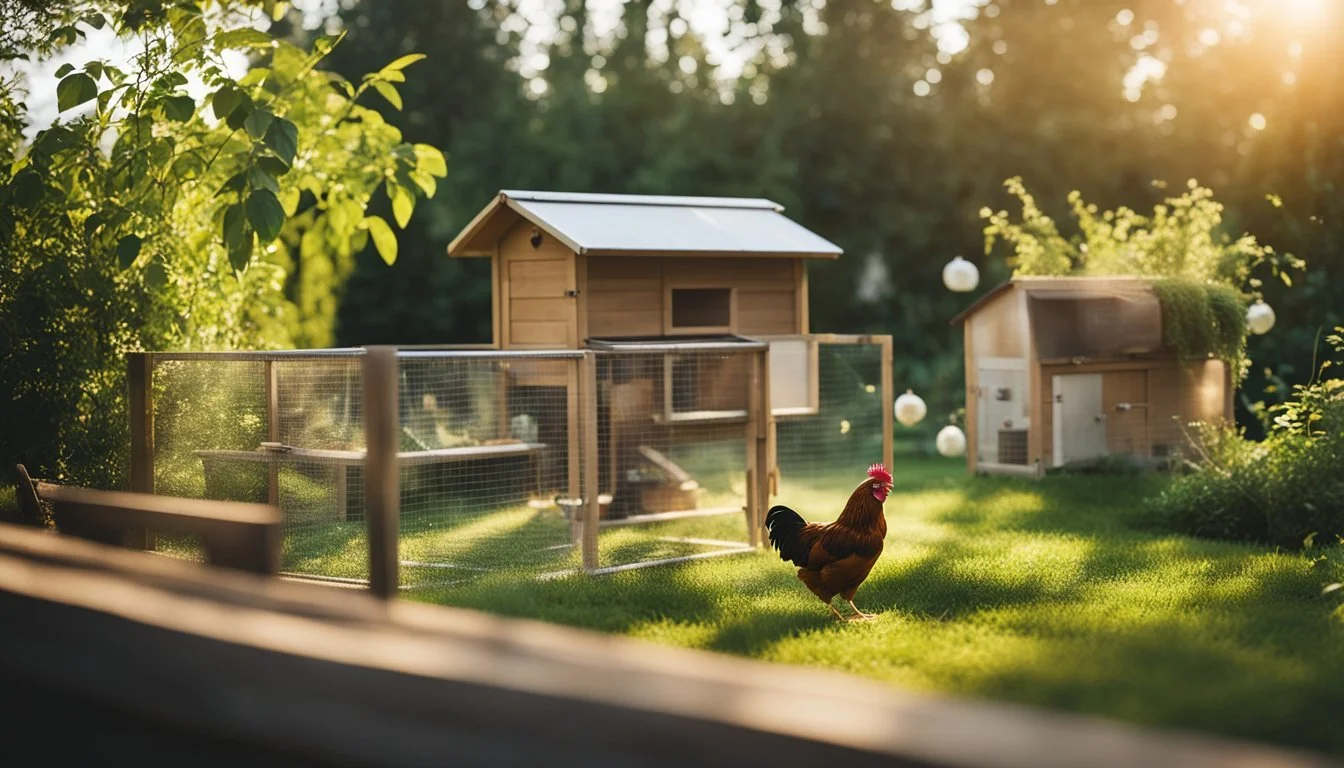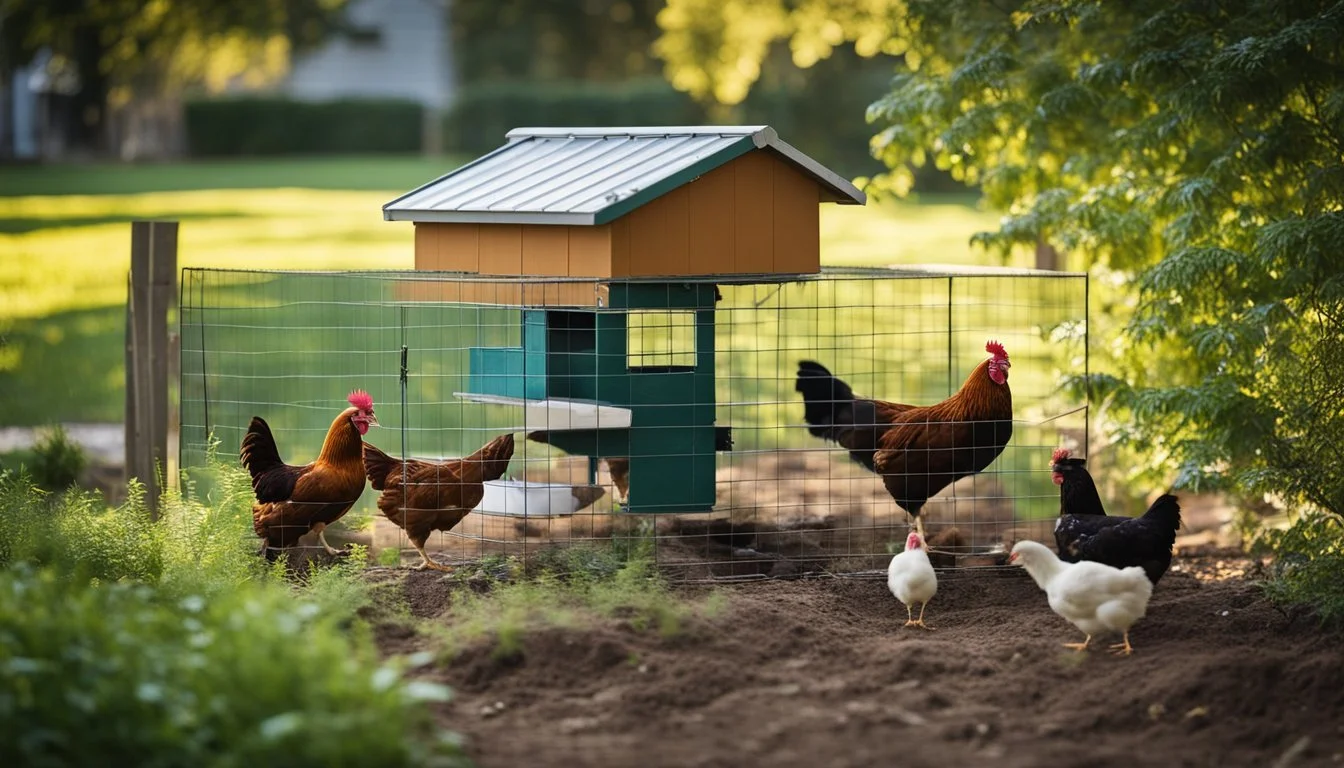7 Tips for Raising Chickens in a Small Backyard
Efficient Methods for Urban Farmers
Raising chickens in a small backyard can be a rewarding and manageable venture for urban and suburban dwellers alike. With the right approach, even limited spaces can sustain a healthy and productive flock. This article offers practical tips to help ensure that your backyard chickens thrive.
Key strategies can optimize your setup, maximize egg production, and ensure the well-being of your chickens. Proper planning and understanding of the essential requirements will enable you to create a nurturing environment despite space constraints. Exploring these tips may be the first step towards a successful backyard chicken-raising experience.
1) Choose Hardy Breeds
Selecting the right breeds is essential for raising chickens in a small backyard. Hardy breeds tend to be more resilient to various environments and conditions. They require less maintenance and are generally healthier.
Buff Orpingtons are a great choice due to their gentle nature and adaptability. Despite their fluffy appearance, they are well-suited for small spaces.
Brahma chickens are another excellent option. They are calm and keep the peace within the flock, making them ideal for backyard settings.
Cochins also make a good addition to small backyard flocks. Known as gentle giants, they are friendly and comfortable with being handled, which is perfect for environments with limited space.
Golden Comets are friendly and prolific egg layers. Their gentle temperament makes them suitable for beginners.
Choosing these hardy breeds can make managing your backyard flock easier and more enjoyable. They are typically more tolerant of varying weather conditions and less prone to disease, ensuring a healthier, happier flock.
2) Optimize coop space
Making the best use of limited coop space is crucial for raising chickens in a small backyard. Each chicken needs approximately 3 to 4 square feet of living space inside the coop. This ensures they have enough room to move comfortably and reduces stress.
Utilize vertical space by incorporating multiple levels. Adding roosting bars at higher locations can help maximize the available space and provide chickens with a natural roosting environment. Ensure these bars are stable and positioned above the nesting boxes.
Nesting boxes are essential for the hens to lay eggs. These should be accessible, yet out of the way of general movement areas. One nesting box for every three to four hens is usually sufficient. Consider using stackable nesting boxes to save floor space.
Incorporate removable trays or sliding floors for easy cleaning. This helps maintain hygiene without taking up additional space. Additionally, think about installing feeders and waterers on the walls to free up more floor area.
Lastly, ensure proper ventilation by installing windows or vents that do not compromise the coop's internal space. Good airflow is key to preventing respiratory issues among chickens and maintaining an optimal living environment.
3) Utilize Vertical Space
In a small backyard, making the most of vertical space is crucial for raising chickens efficiently. Chickens enjoy roosting and perching, so offering them various levels to explore keeps them happy and active.
Install roosts at different heights in the coop. A common setup is to place boards at about counter height with roosts positioned 12-13 inches above. This arrangement gives chickens options for where to perch.
Adding shelves or platforms inside the coop can also make excellent use of vertical space. These can act as additional perches or resting areas for your birds, providing them with varied viewpoints and reducing boredom.
Using vertical space is not only about roosts and shelves. Positioning feeders and waterers at different heights ensures all chickens have easy access without crowding, promoting a healthier environment.
Lastly, consider integrating climbing structures, like ladders or ramps, to encourage chickens to explore vertical areas. This can help simulate their natural behaviors and make the coop more dynamic, keeping your flock entertained and comfortable.
4) Provide Healthy Feed
Chickens thrive on a balanced diet that includes essential nutrients. High-quality feed ensures they grow properly and lay eggs consistently.
Amino acids like methionine and lysine are crucial for their overall health. These should be present in their daily feed.
Vitamins such as A, D3, B12, and E are vital. These vitamins support immune function and overall well-being.
Minerals, including copper sulfate and phosphorus, play a key role in their development. Ensuring these nutrients are present in the feed helps in maintaining strong bones and good health.
For optimal growth, adjust the protein levels in their feed as they age. Chicks need 18-20% protein for the first six weeks.
Feed should also include fiber and enzymes, which aid in digestion. Quality feed helps prevent nutrient deficiencies, digestive issues, and other health problems.
Investing in nutritionally balanced feed for your flock is essential. Additionally, clean and fresh water should always be available.
5) Consider Noise Regulations
When raising chickens in a small backyard, it's important to consider noise regulations in your area. Many local ordinances limit or prohibit the keeping of roosters due to their loud crowing.
Even hens, which are generally quieter, can sometimes make enough noise to disturb neighbors. It’s crucial to know and comply with these rules to maintain good relations with your community.
Check your city’s noise ordinances to see if there are restrictions specific to keeping chickens. This can help you avoid fines or the need to rehome your flock. Remember that even in cities where chickens are allowed, noise complaints can still be an issue.
Investing in a well-designed coop can also help minimize noise. Insulated coops can reduce the sound of clucking and make your backyard flock more discreet. Regularly checking that their needs are met can likewise keep them quieter.
Understanding and following the specific requirements will ensure a smoother experience raising chickens and a happier neighborhood.
6) Install Proper Fencing
Proper fencing is crucial for keeping chickens safe and contained in a small backyard. Start by selecting lightweight wire or mesh materials. These are easy to handle and efficient in preventing escapes.
Choose durable, weather-resistant fence posts. Options like fiberglass step-in posts are suitable due to their longevity and stability.
Secure the wire or mesh to the posts using zip ties or staples. Ensure that the wire is stretched tightly along the length of the fence to avoid sagging.
It is essential to add a skirt along the bottom edge of the fence. Bend an eight to 12-inch wide section of wire into an L-shape and bury it in the ground. This skirt prevents predators from digging under the fence.
Consider adding a secondary wire about 12 inches from the top and slightly inward. This can deter chickens from attempting to hop the fence by creating an additional barrier.
Lastly, regular maintenance is key. Check the fence for wear and tear, fix any gaps, and ensure that all fastenings are secure. This will help keep the chickens safe and contained.
7) Ensure Daily Fresh Water
Chickens need access to fresh water every day to stay healthy and hydrated. Placing multiple water sources in the coop and run ensures every chicken can easily access it.
Using clean containers reduces the risk of contamination. Plastic or galvanized steel waterers work well and are easy to clean.
Water additives like apple cider vinegar, around one tablespoon per gallon, can help maintain clean water and offer health benefits.
In hot weather, water can evaporate quickly, so check levels more frequently. Automated watering systems can simplify this task and ensure consistent availability.
Optimal Space Utilization
Providing adequate space for chickens is essential to their health and well-being. This involves accounting for both horizontal and vertical dimensions to maximize the use of a small backyard.
Space Requirements Per Chicken
Chickens need a specific amount of floor space to thrive. The general rule of thumb is to allow 3-4 square feet of coop space per chicken. For example, a coop housing three chickens should be 9-12 square feet. If the chickens are more active or belong to larger breeds, they might require additional room.
For outdoor runs, the recommendation extends to 8-10 square feet per bird. This space helps maintain cleanliness and reduces stress, preventing issues like feather pecking. Larger spaces also help maintain a healthier environment, allowing grass and soil to recover more efficiently.
Vertical Space Solutions
In compact areas, utilizing vertical space is crucial. Chickens enjoy perching and need opportunities to climb or fly short distances. Installing roosting bars inside the coop can help maximize vertical space. These should be positioned higher than the nesting boxes to encourage proper resting behavior.
Additionally, consider adding platforms or shelves. This provides extra room and enriches the chickens' environment. Ensure there's safe access to these vertical spaces, as they contribute to the chickens' natural behaviors and hierarchy formation. Properly using vertical space not only maximizes the usable area but also keeps chickens happier and healthier.
Choosing The Right Chicken Breed
When choosing the right chicken breed for a small backyard, consider factors like breed size, temperament, and egg production capabilities. Certain breeds are more suited to small spaces and different weather conditions.
Breed Size and Temperament
Choosing a breed with the right size and temperament is crucial for a small backyard. Bantam breeds, such as the Silkies and Sebrights, are smaller and more manageable in limited spaces.
Larger breeds, like Orpingtons and Australorps, might need more room, but they are known for their friendly and calm demeanor.
Additionally, breeds like Golden Comet are good for beginners because of their gentle nature. Selecting a breed compatible with children and other pets can lead to a more harmonious household.
Egg Production Considerations
Different breeds have varied egg-laying capabilities. For high egg production, Lohmann Browns and Golden Comets are excellent choices, laying up to 300 eggs annually.
If you prefer colorful eggs, consider breeds like Araucana for blue eggs or Sussex for a mix of brown and white eggs.
Hybrid breeds like Hybrids are also efficient egg layers, producing around 280 eggs a year with less feed required. Choose a breed based on your egg quantity needs and preferences.
Feeding and Nutrition
Providing proper nutrition is essential for raising healthy chickens. This section outlines the key components of a balanced diet and establishes feeding schedules tailored for different growth stages.
Balanced Diet Essentials
A balanced diet for chickens includes a mix of proteins, carbohydrates, vitamins, and minerals. Protein is crucial, especially for young chicks, to support growth. For meat production, a high-protein feed of 22-24% is recommended for the first six weeks, transitioning to lower protein grower feed thereafter.
Chickens also need essential amino acids like methionine and lysine. Vitamins A, D3, B12, and E are vital, along with minerals such as copper sulfate and phosphorus. Fiber and enzymes aid in digestion, ensuring the chickens can properly process their food.
Feeding Schedules
Establishing a feeding schedule helps ensure chickens receive consistent nutrition. From 0-8 weeks, chicks should have access to starter feed containing 18-20% protein. Between 8-14 weeks, switch to starter/grower feed with 16-18% protein. From 15-18 weeks, a finisher feed with around 16% protein works best.
Regular feeding schedules also reduce waste and ensure all chickens get an equal share of food. Using appropriate feeders can minimize spillage and prevent contamination, securing a clean and efficient feeding environment.



